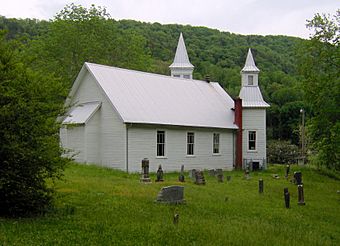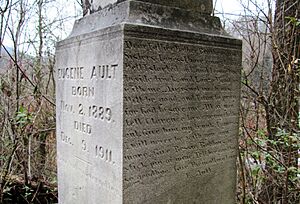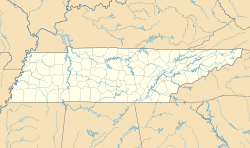Briceville Community Church facts for kids
Quick facts for kids |
|
|
Briceville Community Church and Cemetery
|
|

Briceville Community Church and Cemetery
|
|
| Location | State Route 116 |
|---|---|
| Nearest city | Briceville, Tennessee |
| Area | 3.2 acres (1.3 ha) |
| Built | 1887 |
| Architectural style | Gothic Revival |
| NRHP reference No. | 03000697 |
| Added to NRHP | July 24, 2003 |
The Briceville Community Church is a special church in Briceville, Tennessee, USA. It's a place where people of different Christian beliefs can worship together. Built in 1887, the church was a very important spot for social life and community events in the Coal Creek Valley. This was during a time when coal mining was booming in the late 1800s and early 1900s.
In 2003, the church was added to the National Register of Historic Places. This means it's recognized as an important historical building. It's also a great example of the Gothic Revival architecture style often seen in country areas.
Mining companies found lots of coal in the Coal Creek Valley in the late 1860s. By the 1880s, many mines were open. A train track was built to Briceville in 1888, just one year after the church was finished. The church even served as a temporary jail during the Coal Creek War in 1891. This was a big worker uprising. Later, the church held memorial services for victims of the Fraterville Mine disaster in 1902 and the Cross Mountain Mine disaster in 1911. Many victims from these accidents are buried in the church's cemetery. The church was home to a Methodist group until 1995, and it's still used for community events today.
Contents
Where is the Briceville Church Located?
The Briceville Community Church sits on top of a small hill. This hill is at the southern end of "Root Hog Ridge," which is part of Vowell Mountain. The church is right in the middle of Briceville. The hill is about 20 feet (6 meters) higher than the land around it. This means you can see the church from almost anywhere in the community.
The church stands at the edge of the hill. Its cemetery stretches north from the back of the church, going up the hillside. Some gravestones are even among the trees at the edge of the property. State Highway 116 runs along the bottom of the hill. The Briceville community is at the top end of the Coal Creek Valley. This is a narrow valley between Walden Ridge and the rougher parts of the Cumberland Mountains.
A Look Back: History of the Church
A train line was finished from Knoxville to Coal Creek (now called Rocky Top) in the late 1860s. This led to a big mining boom in the Coal Creek Valley. In 1888, a special train track was built up the valley to Slatestone Hollow. This happened because Ohio Senator Calvin Brice pushed for it. Because of him, the Slatestone community was renamed "Briceville."
The Briceville Community Church was built by volunteers in 1887. John Moore donated the land for it. At first, the church welcomed people from all Christian groups. But by 1896, it became a Methodist church. This was because the Baptist and Presbyterian groups in Briceville had grown enough to build their own churches.
The Coal Creek War and the Church's Role
Historians say that places like churches helped bring people together. This unity played a part in the Coal Creek War. This was a worker uprising that started in 1891. It began when the Tennessee Coal Mining Company decided to use workers from prisons to break a strike at their Briceville mine.
The conflict started on July 14, 1891. Several armed miners surrounded the company's prison camp in Briceville. They marched the prison workers out of the valley. Briceville stayed at the center of this uprising until it was stopped by the Tennessee state army in August 1892. The Briceville Community Church was used as a temporary jail. Dozens of miners arrested by the army were held there after the conflict.
Remembering Mine Disasters

On June 8, 1902, memorial services were held at the Briceville Community Church. Local doctor and pastor E. S. Dickson led these services. They were for the victims of the Fraterville Mine disaster. This was a mine explosion that killed 216 miners at the Fraterville Mine, just north of Briceville.
Another mine disaster happened at the Cross Mountain Mine on December 9, 1911. This mine was about a mile west of the church. This explosion killed 84 miners. Many of the victims were buried in a circle called the Cross Mountain Miners' Circle. This circle is on the slopes of Walden Ridge. However, several victims were buried in the Briceville Community Church Cemetery. One of them was Eugene Ault (1889–1911). His gravestone has a "farewell message" carved into it. Ault had written this message on a mine wall as he was dying.
Changes Over Time
After World War II, mining companies slowly left Briceville. This was because people across the country needed less coal. As a result, fewer people attended the Briceville Community Church. Between 1947 and 1965, the church's pastor, Ralph Cline, and church member Anna Mae Evans started many programs. These programs helped the community get more involved with the church.
These programs included summer Bible school classes and a community Thanksgiving service. They also had an annual New Year's Eve service. This service ended with the church's bell ringing at midnight. It was also during Cline's time that a fellowship hall was built in the church's basement. Regular Methodist services continued at the church until June 1995. At that time, the Methodist Church gave the building to two local trustees. The church is still used today for community events like weddings and funerals. It also serves as a safe place for Briceville Elementary School (which is across the street) in case of emergencies.
Church Design and Features
The Briceville Community Church has walls made of painted wood. It also has a basement and a pointed roof. The building would look quite simple if it weren't for its two special towers. These towers are in the Gothic Revival style and are connected to the front corners of the church.
Both towers have slatted openings for bells and pyramid-shaped roofs. However, the tower on the east side is taller than the one on the west. It also has a slightly different look. The east tower holds the church's bell, which was made in 1919. A brick chimney was added behind the west tower in the 1950s.
Doors at the bottom of both towers lead into the church's main worship area, called the sanctuary. The sanctuary has a carpeted wooden floor and oak benches, which were put in during the 1950s. It also has a pulpit with wooden panels. A set of wooden stairs goes down to the church's basement. This basement has a fellowship hall and classrooms for Sunday school, which were built in the 1950s.
The Church Cemetery
The church's cemetery is also an important part of its historical listing. It covers almost an acre of land on the west and north sides of the church. The oldest grave marker in the cemetery belongs to Henry Mears, who passed away on March 31, 1891. Most of the grave markers face east to west. They are usually simple stone slabs or tall, narrow monuments called obelisks.
You can see many symbolic carvings on the gravestones. These include symbols from the Victorian era, like open Bibles, praying hands, stars, and doves. There are also symbols for groups like the Independent Order of Odd Fellows and the Freemasons.





